|
|
|
Sort Order |
|
|
|
Items / Page
|
|
|
|
|
|
|
| Srl | Item |
| 1 |
ID:
182775
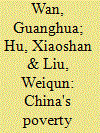

|
|
|
|
|
| Summary/Abstract |
Miracle reductions in absolute poverty led China to announce, in late 2019, the strategic change from targeting absolute poverty to targeting relative poverty. After highlighting China's success in the fight against absolute poverty, this paper attempts to assess the roles of growth and income inequality in affecting both absolute and relative poverty rates. Poverty decomposition and panel-VAR modelling results show that growth played an overwhelming role in achieving the miracle of poverty reduction but relative poverty has been consistently rising. And growth, contrary to the case of absolute poverty, actually has contributed to the rising trend of relative poverty. Conversely, income inequality has played a small role in aggravating absolute poverty but a moderate role in raising relative poverty. Therefore, it seems appropriate for China to continue targeting absolute poverty with a higher poverty line. In the case that China insists on shifting the poverty alleviation strategy, market-led growth can no longer be relied on to reduce relative poverty. Instead, government-led pro-poor policies must be instituted by providing employment, education, training and other opportunities to the disadvantaged groups, in addition to the usual social assistance.
|
|
|
|
|
|
|
|
|
|
|
|
|
|
|
|
| 2 |
ID:
113679


|
|
|
|
|
| Publication |
2012.
|
| Summary/Abstract |
This paper assesses both interregional and intraregional innovation inequality in China from 1995 to 2006. It is revealed that the east-central-west inequality has increased over time, whereas the inter-provincial inequality showed a V-pattern until 2003; Both inequality measures oscillated from 2004 to 2006. Using a decomposition framework recently developed by one of the authors, we determined that the major factors driving innovation inequality are population, economic development level, R&D, location and openness. The aggravated innovation inequality reflects the growth of China's innovation centers in the eastern region and their admission into the global innovation networks. The fact that R&D is a major factor driving the inequality suggests that, considered in the present study, the efficiency of R&D investment improved in certian regions during the period (1995-2006). Finally, geographic location and openness affect innovation inequality primarily through the coupled evolution of innovation capability and economic development, resulting in first-mover advantages to provinces of the eastern region.
|
|
|
|
|
|
|
|
|
|
|
|
|
|
|
|
| 3 |
ID:
130972
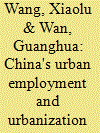

|
|
|
|
|
| Publication |
2014.
|
| Summary/Abstract |
The present paper argues that China's existing population and employment statistics are misleading, and have failed to include many of the migrant and labor force flows between urban and rural areas. The paper reconciles the differences between official census data and other survey statistics and attempts to recalculate China's urban population and employment figures. Our analyses indicate that official statistics of 2012 underestimate China's urban employment by approximately 47 million while overestimating rural employment by 31 million. The adjusted urbanization rate exceeded 55 percent in 2012, almost 3 percentage points higher than the official statistics. Nevertheless, there remains much potential for rural-to-urban migration. More specifically, if the current bottlenecks in household registration, social security and public welfare systems can be removed or relaxed, China's urbanization rate could rise by another 10 percentage points or even more over the next decade.
|
|
|
|
|
|
|
|
|
|
|
|
|
|
|
|
| 4 |
ID:
161830
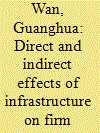

|
|
|
|
|
| Summary/Abstract |
This paper attempts to distinguish and estimate the direct and indirect effects of infrastructure on firm productivity. The latter arises from the infrastructure-agglomeration link and has been largely overlooked in the literature on infrastructure. An analytical framework is then proposed to estimate both effects. Finally, empirical results are obtained using large-scale firm-level survey data from China. Major findings include: (1) all the three kinds of infrastructure–road, telecommunication servers and cable–are found to directly promote firm productivity; (2) they also exert a positive indirect effect on firm productivity through the agglomeration channel; and (3) the empirical results are robust to different agglomeration indicators and different subsamples.
|
|
|
|
|
|
|
|
|
|
|
|
|
|
|
|
| 5 |
ID:
147499


|
|
|
|
|
| Summary/Abstract |
China achieved average GDP growth of nearly 10 percent over the period 1978–2015. However, how long can such high levels of growth be sustained, especially when per capita GDP levels have reached middle-income status, and the normal tendency of economies is to slow down as they mature? This paper reviews the recent literature on the determinants and outlook for real GDP growth in China and addresses some of the key issues, including identifying supply-side factors that can support continued strong growth under favorable conditions, as well as risk factors that might cause growth to fall short. The paper reviews supply-side determinants of growth using a growth accounting framework, and also assesses major demand-side factors driving potential growth, including exports, capital formation and household consumption.
|
|
|
|
|
|
|
|
|
|
|
|
|
|
|
|
| 6 |
ID:
077187
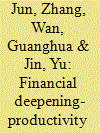

|
|
|
|
|
| Publication |
2007.
|
| Summary/Abstract |
The financial intermediation-growth nexus is a widely studied topic in the literature of development economics. Deepening financial intermediation may promote economic growth by mobilizing more investments, and lifting returns to financial resources, which raises productivity. Relying on provincial panel data from China, this paper attempts to examine if regional productivity growth is accounted for by the deepening process of financial development. Towards this end, an appropriate measurement of financial depth is constructed and then included as a determinant of productivity growth. It finds that a significant and positive nexus exists between financial deepening and productivity growth. Given the divergent pattern of financial deepening between coastal and inland provinces, this finding also helps explain the rising regional disparity in China
|
|
|
|
|
|
|
|
|
|
|
|
|
|
|
|
| 7 |
ID:
093846
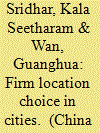

|
|
|
|
|
| Publication |
2010.
|
| Summary/Abstract |
This paper contributes to the industrial location literature by examining why industry locates or refrains from locating in large, medium and small cities of India, China and Brazil using firm-level data from the World Bank. Results from ordered logistic regressions indicate that capital cities are not attractive for firms to locate, when they are large. In India and China, labor intensive firms do not locate in large cities. Proximity to inputs has a positive impact on firm location in China. While availability of inputs has a positive impact on firm location in India, the availability of raw materials has a negative impact on firm location in Brazil. Firms established in post-reform period in India tend to locate in large cities; in China, these firms avoid medium and large cities. The implications for urban governance in these countries are discussed.
|
|
|
|
|
|
|
|
|
|
|
|
|
|
|
|
| 8 |
ID:
158908


|
|
|
|
|
| Summary/Abstract |
In the post‐reform era, China achieved poverty reduction that was unprecedented in human history This poverty reduction was accompanied by fast growth and worsening income distribution. The present paper examines the poverty–growth–inequality triangle in China by: (i) providing growth, inequality and poverty profiles at the national and provincial levels; (ii) uncovering the contributions of growth and inequality changes to poverty reduction; and, finally, (iii) drawing lessons for other developing countries. Based on the World Bank's definition of the poverty line, China has already eliminated abject poverty, even though the poverty rate was as high as 88.3 percent in 1981. The remarkable record in poverty reduction is predominantly attributable to growth. The effect of inequality varied in different periods. In addition, the impact of growth on poverty reduction is found to be diminishing over time, a phenomenon worth further research and policy attention.
|
|
|
|
|
|
|
|
|
|
|
|
|
|
|
|
| 9 |
ID:
161829


|
|
|
| 10 |
ID:
120052


|
|
|
|
|
| Edition |
vol. 2012/2
|
| Publication |
Beijing, Social Science Academic Press, 2012.
|
| Description |
191p.pbk
|
| Standard Number |
9787509735381
|
|
|
|
|
|
|
|
|
|
|
|
Copies: C:1/I:0,R:0,Q:0
Circulation
| Accession# | Call# | Current Location | Status | Policy | Location |
| 057212 | 320.91824/WAN 057212 | Main | On Shelf | General | |
|
|
|
|
| 11 |
ID:
120055


|
|
|
|
|
| Edition |
vol. 2012/3
|
| Publication |
Beijing, Social Science Academic Press, 2012.
|
| Description |
157p.pbk
|
| Standard Number |
9787509738863
|
|
|
|
|
|
|
|
|
|
|
|
Copies: C:1/I:0,R:0,Q:0
Circulation
| Accession# | Call# | Current Location | Status | Policy | Location |
| 057213 | 320.91824/WAN 057213 | Main | On Shelf | General | |
|
|
|
|
| 12 |
ID:
099941


|
|
|
|
|
| Publication |
New York, Palgrave Macmillan, 2010.
|
| Description |
xxii, 284p.
|
| Standard Number |
9780230252728, hbk
|
|
|
|
|
|
|
|
|
|
|
|
Copies: C:1/I:0,R:0,Q:0
Circulation
| Accession# | Call# | Current Location | Status | Policy | Location |
| 055435 | 330.48251/SAN 055435 | Main | On Shelf | General | |
|
|
|
|
| 13 |
ID:
111485
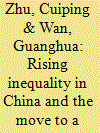

|
|
|
|
|
| Publication |
2012.
|
| Summary/Abstract |
China faces serious external (i.e. trade) and internal (i.e. structural) imbalances. Both are related to income inequality, reduction of which will help to increase domestic demand. This paper discusses how income inequality has evolved over time. This is followed by an exploration of the consequences of high inequality. Driving forces underlying the rising inequality are analyzed before providing concrete policy recommendations. It is found that inequality declined in the early period of reform, until the mid to late 1980s, and then began a rising trend up to 2010. Major determinants of inequality include: location, institutional and policy factors, trade and globalization, and education inequality and human capital gaps along rural-urban and spatial divisions. To achieve a balanced economy and a harmonious society, development policies in China must shift from emphasizing growth to prioritizing equality. In addition, government interventions can target rural-urban disparity through rapid urbanization, and tackle regional inequality by developing financial markets, ensuring progressive allocation of fiscal resources, promoting trade and foreign direct investment in inland China, creating more formal jobs and supporting the service sector.
|
|
|
|
|
|
|
|
|
|
|
|
|
|
|
|
| 14 |
ID:
178480


|
|
|
|
|
| Summary/Abstract |
Although China is experiencing a deterioration in wealth distribution where housing is playing a dominant role, this issue has received scant research attention despite its importance. Combining four rounds of the China Household Finance Survey (CHFS) data, this paper measures and discusses wealth inequality in China, with a special emphasis on the contribution of housing. Our analysis reveals that housing is the largest contributor to wealth inequality, responsible for around 70 percent of total wealth inequality, and its contribution has been increasing over time. Our research efforts have focused on the housing wealth disparity, exploring its composition from alternative perspectives. The results show that housing wealth inequality has also been rising over time and an absolute majority of housing wealth inequality is due to within-group gaps. Finally, we employ Wan's (2004) regression-based decomposition methodology to quantify the contributions of different determinants to housing wealth disparity in China, and to demonstrate serious biases in the conventional approach that is often used to analyze housing wealth inequality.
|
|
|
|
|
|
|
|
|
|
|
|
|
|
|
|
|
|
|
|
|